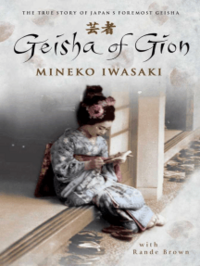Take a photo of a barcode or cover
informative
inspiring
relaxing
fast-paced
funny
informative
lighthearted
reflective
fast-paced
This didn't read very much like a biography at times, but I still very much enjoyed it. Learning about the behind scenes of geisha was truly fascinating. I did find it hard to believe that anyone can so clearly remember being 2-5 years old.
challenging
hopeful
informative
medium-paced
emotional
informative
reflective
medium-paced
informative
lighthearted
reflective
medium-paced
informative
Very informative, learn so much about Japanese culture and the world of geishas. Particularly loved her descriptions of her innocence towards life outside her bubble as a geisha. Also really admire her dedication to the craft.
I started Geisha: A Life because I had long ago read Memoirs of a Geisha and then discovered that this was the original life of Mineko Iwasaki, an autobiography written by her telling her true story and a much more accurate history of geishas in Japan. Wanting to read something similar to Memoirs of a Geisha, and finding out about the polemic between Arthur Golden and Mineko Iwasaki, I decided to read this book to get a real and historical point of view.
However, this is a DNF for me, and here's why:
First of all, it's true that the author provides a very detailed, accurate and historical portrait of the geishas of Japan. Iwasaki describes the geisha lifestyle through her own experiences and gives us full paragraphs writing about the clothes, the hairstyles, the traditional dances and arts, even the finances. It was very informative and interesting, and at first I really enjoyed reading it.
About halfway through the book my interest began to wane. The book is well documented, of course, but after a while it started to feel like I was reading a Wikipedia page. A lot of descriptions, a lot of technical terms, a lot of Japanese words and concepts that after a while just became too much to remember, at least as a western reader not very familiar with the Japanese language. It started to feel like just too much information. If the aim of the book is to introduce the western reader to the traditional geisha culture of Japan, I think a little less technicality would have made the book smoother and with a better pace.
There was also something that bothered me from the beginning: was this book an autobiography or a historical essay? As far as I understand it, it is an autobiography, but it has no soul. The narrative has no emotions, no feelings, no depth or complexity of characters. It is much more historically accurate than Memoirs of a Geisha, but sadly it completely lacks its emotion, its sensual writing, its beautiful descriptions.
I think it's very hard for the reader to connect with the main character, Mineko, or any other character. Mineko tells us memories from when she was 2 or 3 years old, and she describes these memories with an incredible amount of detail and information. This is simply impossible, yet she tells it as if it were the objective truth of what happened and how she experienced these moments of her life. As the story progresses, it becomes clear that Mineko is not humble and not empathetic but a spoiled, selfish girl who sees herself as the centre of the universe. She is a very difficult character, and because the book does not allow us any introspection or access to her inner monologue, she ends up being a very unlikeable character. It is impossible to feel empathy or sympathy for her.
There are no supporting characters worth mentioning. Yes, we have a few names and other geishas who take part in the story, but again, we don't really get to know them and we don't get any insight into their relationship with Mineko. The author spends paragraphs talking about textures, fabrics, dances and instruments, but then explains in just two sentences that she was very sad during this period of her life and even thought about committing suicide. After those two sentences she moves on and it is never mentioned again. How am I supposed to connect with her when every emotional or deep passage is brushed away?
In the end, it became clear that my interest in the story was waning. I couldn't relate to the main character and was getting bored. I decided to stop reading for a while, to take a break, but in the end I never felt like picking it up again. I just didn't have the desire or interest to continue the story.
Such a shame, because I really would have liked to learn more about geishas, away from the male American gaze, but this was just not the book for me.
However, this is a DNF for me, and here's why:
First of all, it's true that the author provides a very detailed, accurate and historical portrait of the geishas of Japan. Iwasaki describes the geisha lifestyle through her own experiences and gives us full paragraphs writing about the clothes, the hairstyles, the traditional dances and arts, even the finances. It was very informative and interesting, and at first I really enjoyed reading it.
About halfway through the book my interest began to wane. The book is well documented, of course, but after a while it started to feel like I was reading a Wikipedia page. A lot of descriptions, a lot of technical terms, a lot of Japanese words and concepts that after a while just became too much to remember, at least as a western reader not very familiar with the Japanese language. It started to feel like just too much information. If the aim of the book is to introduce the western reader to the traditional geisha culture of Japan, I think a little less technicality would have made the book smoother and with a better pace.
There was also something that bothered me from the beginning: was this book an autobiography or a historical essay? As far as I understand it, it is an autobiography, but it has no soul. The narrative has no emotions, no feelings, no depth or complexity of characters. It is much more historically accurate than Memoirs of a Geisha, but sadly it completely lacks its emotion, its sensual writing, its beautiful descriptions.
I think it's very hard for the reader to connect with the main character, Mineko, or any other character. Mineko tells us memories from when she was 2 or 3 years old, and she describes these memories with an incredible amount of detail and information. This is simply impossible, yet she tells it as if it were the objective truth of what happened and how she experienced these moments of her life. As the story progresses, it becomes clear that Mineko is not humble and not empathetic but a spoiled, selfish girl who sees herself as the centre of the universe. She is a very difficult character, and because the book does not allow us any introspection or access to her inner monologue, she ends up being a very unlikeable character. It is impossible to feel empathy or sympathy for her.
There are no supporting characters worth mentioning. Yes, we have a few names and other geishas who take part in the story, but again, we don't really get to know them and we don't get any insight into their relationship with Mineko. The author spends paragraphs talking about textures, fabrics, dances and instruments, but then explains in just two sentences that she was very sad during this period of her life and even thought about committing suicide. After those two sentences she moves on and it is never mentioned again. How am I supposed to connect with her when every emotional or deep passage is brushed away?
In the end, it became clear that my interest in the story was waning. I couldn't relate to the main character and was getting bored. I decided to stop reading for a while, to take a break, but in the end I never felt like picking it up again. I just didn't have the desire or interest to continue the story.
Such a shame, because I really would have liked to learn more about geishas, away from the male American gaze, but this was just not the book for me.
The matter-of-fact telling of this true story could have felt bland in other scenarios, but it seemed so true to form for Mineko’s personality and character. It is always fascinating to learn about an unfamiliar culture, and although I have previously read “Memoirs of a Geisha,” there’s something about this being a memoir that lends such power to the telling. If I had one criticism, it would be that I wished we learned more about the day-to-day activities of Mineko’s life as a geiko, how she interacted with her guests, and how she applied the art of hosting and being a geiko to situations during her work.
If you like books by people with no humility who believe they are the absolute best of everything and no one will ever be better than they are, then this is for you!





